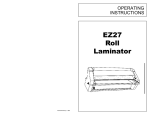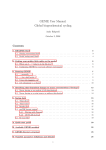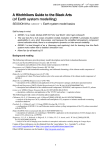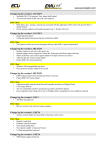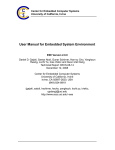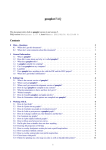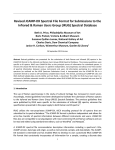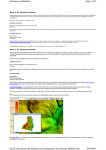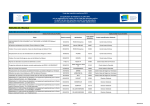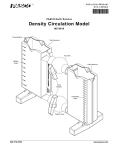Download A Hitchhikers Guide to the Black Arts (of Earth system modelling)
Transcript
UoB Earth system modelling workshop: 26th – 27th August 2009 SESSION #2a: Atlantic meridional overturning circulation stability and global warming A Hitchhikers Guide to the Black Arts (of Earth system modelling) SESSION #2a: Atlantic meridional overturning circulation stability and global warming Stuff to keep in mind: • Nothing at all – keep your mind completely empty and let the wonderful truths of the GENIE-1 model permeate your entire being. Background reading Rahmstorf et al. [2006] (In: Encyclopedia of QuaternarySciences, Edited by S. A. Elias. Elsevier, Amsterdam) → Provides the background to the Atlantic Meridional Overturning Circulation, or ‘Thermohaline Ocean Circulation’ and its hypothesized hysteresis loop. Hargreaves, J. C., J. D. Annan, N. R. Edwards, R. Marsh, An efficient climate forecasting method using an intermediate complexity Earth System Model and the ensemble Kalman filter, Climate Dynamics, Volume 23, Issue 7 - 8, Dec 2004, Pages 745 - 760. Marsh R., A. Yool, T. M. Lenton, M. Y. Gulamali, N. R. Edwards, J. G. Shepherd, M. Krznaric, S. Newhouse, S. J. Cox, Bistability of the thermohaline circulation identified through comprehensive 2-parameter sweeps of an efficient climate model, Climate Dynamics, Volume 23, Issue 7 - 8, Dec 2004, Pages 761 - 777. 1 UoB Earth system modelling workshop: 26th – 27th August 2009 SESSION #2a: Atlantic meridional overturning circulation stability and global warming 9. Geochemical forcing of GENIE (“poking the climate beast” [Wally Broecker]) 9.0 The BIOGEM ocean biogeochemistry module in GENIE provides a framework for applying time- and spatially-variable ‘forcings’ of the Earth system – fluxes or restored-to boundary conditions that can be prescribed for any gas, dissolved substance, or particulate, and including temperature and salinity. Examples include freshwater input (== a negative salinity flux forcing) of the North Atlantic to alter ocean circulation, fossil fuel CO2 emissions to the atmosphere (== a CO2 gas flux forcing), or aeolian iron supply to the surface ocean (based on a 2-D detrital, dust flux forcing field). 9.1 Section 4 in the User Manual describes the original and most flexible provision for applying time-dependent forcings. However, a simpler :) way is provided of applying forcings in GENIE compared to the gobbledygook in the User Manual, and geochemical fluxes (or boundary conditions) can be specified in just a few additional lines in the user config file if the forcing has a simple spatial pattern (e.g., fluxes applied equally to the entire ocean, to the entire surface, or to a single location in the ocean). View the user config file exp6_colorinjection. You will see the following new lines (under the heading # --- FORCINGS ---): bg_ctrl_force_oldformat=.false. bg_par_fordir_name="~/genie_forcings/pyyyyz_Fred" bg_par_force_point_i=22 bg_par_force_point_j=33 bg_par_force_point_k=8 bg_par_ocn_force_scale_val_48=0.0 The first line simply tells GENIE to ignore the complicated way of specifying forcings (Section 4 in the User Manual). The second line points GENIE to a set of files that define what geochemical property is going to be altered plus information about how the forcing changes with time (if at all). These two lines you do not need to worry about any further here. There are three lines (bg_par_force_point_i=20, ...) that specify the location in the ocean of the geochemical forcing is going to be applied. The point sources are specified in (i,j,k) coordinates, which in this case is (22,33,08). For the ocean model resolution we are using, the grid is 36×36×16, longitude (i) is counted from left-to-right (1 to 36); latitude (j) is counted from bottom-to-top (1 to 36); level depth (k) is counted from downwards top-to-bottom (16 down to 1). Thus, (22,33,08) is a release of tracer in the North Atlantic, a little south of Greenland, and intermediate depth (level = 8 out of 16). Refer to the Figure for grid information. Finally, there is a scaling parameter (bg_par_ocn_force_scale_val_48) which specifies the magnitude of the flux to be applied (in units of mol yr-1). 9.2 You are going to run a brief experiment in which you will be injecting a conservative dye tracer in the ocean. BIOGEM has two tracers defined for this purpose – ‘blue’ and ‘red’. Open the user config file: exp6_colorinjection and edit the namelist parameter controlling the flux of red dye to read: bg_par_ocn_force_scale_val_48=1.0E12 which specifies a flux of 1.0×1012 (mol yr-1). Remove the snowball configured GENIE executable program – from ~/genie/genie-main, type: $ make cleanall and return to the home directory. The experimental design is a little different from the previous modern simulation in that a new base config (genie_eb_go_gs_ac_bg_itfclsd_16l_JH) is being used – this specifies a higher resolution ocean model with 16 levels in the vertical, hence the 16l (short for 16 levels – don’t get the one (1) and el (l) mixed up – it is almost impossible to distinguish them on the computer terminal screen). (The iftclsd is short for ‘Indonesian through-flow closed’, while JH is the person’s initials I created the base config originally for …). Also now included is seasonality of solar insolation. Run the model for 101 years using a new pre-industrial spin-up that is provided as a re-start: $ ./old_rungenie.sh genie_eb_go_gs_ac_bg_itfclsd_16l_JH ~/genie_userconfigs exp6_colorinjection 101 ~/genie_output/modern_16level_SPINUP 2 UoB Earth system modelling workshop: 26th – 27th August 2009 SESSION #2a: Atlantic meridional overturning circulation stability and global warming View the results – the impact on the Red tracer distributions in NetCDF time-slice files. For instance, the 2D NetCDF file (fields_biogem_2d.nc) has fields of bottom-water properties which facilitate tracking the dispersal of tracers released at depth (e.g., variable: ocn_colr). Changes in tracer inventory with time can be tracked in the time-series file biogem_series_ocn_colr.res. Spend a little while altering the flux (bg_par_ocn_force_scale_val_48) and/or location (bg_par_force_point_i, bg_par_force_point_j, bg_par_force_point_k) of tracer input. Note how you can use conservative tracers to help diagnose (and better understand) the circulation of the ocean. 36 35 34 33 32 31 30 29 28 27 26 25 24 23 22 21 20 19 18 17 16 15 14 13 12 11 10 09 08 07 06 05 04 03 02 01 10 94 94 94 94 94 91 91 91 91 91 91 93 91 93 91 93 91 93 09 04 01 01 01 01 01 01 02 01 02 03 03 02 02 94 94 09 94 94 91 91 91 91 91 91 91 91 08 06 05 06 07 09 91 91 91 93 03 02 04 08 10 09 08 03 01 02 03 02 01 10 94 08 94 94 91 91 91 91 91 16 09 05 02 02 03 04 05 04 04 07 07 07 92 93 93 93 93 93 12 03 01 01 02 02 01 09 94 09 94 94 91 91 11 07 08 05 03 02 01 01 01 01 02 02 03 08 10 14 94 91 91 91 93 92 92 05 02 01 02 02 02 09 94 10 94 92 16 10 05 02 02 01 01 02 02 02 02 02 03 02 03 07 10 10 10 09 13 91 91 91 91 92 07 04 04 03 03 08 94 11 94 92 09 04 01 01 01 01 01 01 01 01 01 01 03 03 03 05 07 05 04 04 06 08 07 05 04 03 02 02 02 03 03 07 94 11 94 08 04 01 01 01 01 01 01 01 01 01 01 01 02 02 02 03 04 03 04 04 04 06 05 06 06 05 04 04 05 04 03 06 94 10 94 07 03 01 01 01 02 01 01 01 02 02 01 01 01 01 01 01 01 01 03 04 04 04 03 03 04 07 10 12 07 03 01 03 94 08 94 10 04 01 01 01 01 01 01 01 02 01 01 01 01 01 01 01 01 01 03 04 04 03 02 01 01 01 02 03 02 01 01 04 94 07 16 15 05 01 01 01 01 01 01 02 02 01 01 01 01 01 01 01 01 02 02 01 01 01 01 01 01 01 01 02 01 01 02 03 94 07 94 12 03 01 01 01 01 01 01 01 01 01 01 01 01 02 02 01 01 01 01 01 02 01 01 01 01 01 01 01 01 02 03 03 94 07 94 09 03 01 01 01 01 01 01 01 01 01 01 01 01 02 02 02 01 01 02 03 03 02 02 02 01 01 01 01 01 03 03 02 94 07 94 93 06 04 03 02 01 01 02 01 01 01 01 01 01 02 02 02 02 02 02 03 03 02 02 02 02 02 01 01 02 03 02 02 94 07 94 93 93 11 08 05 03 03 02 02 02 02 02 02 02 02 02 02 02 02 02 03 03 03 03 03 02 02 02 02 03 03 02 02 94 11 94 94 93 93 93 93 93 10 07 05 04 03 02 02 03 03 02 02 02 03 03 03 03 04 04 04 03 03 03 04 04 03 02 02 94 13 94 94 91 91 91 91 93 93 91 91 91 06 04 03 03 03 04 03 03 03 03 03 02 02 03 03 03 03 03 03 02 02 01 02 94 14 94 94 91 91 91 91 92 92 13 08 09 91 06 04 03 03 04 04 03 02 02 02 02 02 03 03 03 03 03 02 02 01 01 02 94 14 91 91 91 91 91 91 92 92 09 07 08 10 91 07 07 05 05 05 03 02 02 02 02 02 03 03 03 03 03 03 02 02 01 03 94 12 91 91 91 91 91 09 06 05 04 04 05 06 05 91 91 91 91 91 91 91 91 91 04 02 03 03 03 04 06 08 08 05 02 05 94 12 14 91 91 91 12 03 01 01 01 01 02 03 04 08 91 91 91 91 91 91 91 91 93 93 93 93 93 93 93 93 93 05 04 09 94 93 12 06 09 12 06 01 01 01 01 01 01 01 01 03 07 11 91 91 91 91 91 91 91 91 91 91 91 09 05 03 04 05 04 07 94 93 93 05 05 05 03 01 02 03 02 02 02 03 02 01 02 04 05 08 91 91 91 91 91 91 09 06 04 02 01 01 01 04 04 04 94 91 91 05 03 03 03 03 04 03 01 01 01 01 01 01 01 02 03 04 05 05 04 03 03 03 02 02 02 02 01 01 01 03 03 02 94 91 12 06 04 03 03 04 03 01 01 01 01 02 02 01 02 02 02 01 01 01 01 01 01 01 01 01 02 02 02 02 01 02 02 01 94 09 09 09 06 03 02 02 02 03 05 09 12 12 10 07 05 03 02 02 02 03 03 03 03 03 02 03 03 03 04 03 03 02 02 01 94 05 06 12 93 11 09 93 12 93 93 93 93 93 93 93 93 05 02 02 02 02 02 01 01 01 01 02 02 02 02 03 04 04 02 02 94 05 07 93 93 93 93 10 10 93 93 93 93 93 93 93 93 08 04 03 02 01 01 01 01 02 02 02 02 01 01 02 03 04 01 03 94 08 12 93 93 93 93 10 08 12 94 94 94 94 94 94 93 93 93 93 93 93 93 93 93 93 10 07 06 03 01 01 02 03 01 03 94 10 94 94 94 94 94 94 08 11 94 94 94 94 94 94 93 93 93 93 93 91 91 91 93 93 93 93 93 05 02 01 01 02 01 03 94 11 94 94 94 94 94 94 11 94 94 94 94 94 94 94 91 91 91 91 91 91 91 91 91 10 07 05 04 02 02 03 02 02 01 04 94 11 94 94 94 94 94 94 94 94 94 91 91 91 91 91 91 11 07 04 03 03 04 07 09 08 05 04 03 03 04 05 04 02 01 06 94 11 94 94 94 94 94 94 94 94 92 16 14 09 05 03 03 02 02 02 03 03 03 03 03 02 01 01 02 02 02 02 03 01 01 06 94 12 94 94 94 94 94 94 94 94 92 09 06 03 02 02 02 02 02 02 04 04 04 03 03 03 02 02 02 02 02 02 04 03 02 06 94 12 94 94 94 94 94 94 94 92 92 92 92 92 11 09 06 04 03 02 02 01 01 02 01 02 02 03 03 03 03 04 06 05 04 08 94 11 94 94 94 94 94 94 94 92 92 92 92 08 05 04 03 03 02 01 01 01 02 02 01 01 02 03 04 03 03 03 03 03 03 08 94 11 94 94 94 94 94 94 94 92 92 92 92 11 09 08 08 07 04 02 01 01 01 01 01 01 01 02 03 02 03 03 03 02 03 94 94 01 02 03 04 05 06 07 08 09 10 11 12 13 14 15 16 17 18 19 20 21 22 23 24 25 26 27 28 29 30 31 32 33 34 35 36 GENIE-1 grid (worjh2 configuration). Light blue numbers are the ‘i’ co-ordinates. Green numbers are the ‘j’ co-ordinates. The depth of the ocean at any location is indicated by its ‘k’ value – a number between 1 and 16, with 16 being the surface layer of the ocean, and 1 the maximum possible depth anywhere. Numbers > 90 (91, 92, 93, 94) and shaded grey are land (and specify the direction of run-off). Location (22,33,08) is highlighted in yellow. You can follow the progress of the dye (and hence diagnose the properties of ocean circulation in the model) by plotting vertical and/or horizontal slices that go through (or near) the cell location in which you inject the dye tracer (3D netCDF file). You can also plot the overturning circulation from the 2D netCDF file – variable phys_opsi = global overturning streamfunction, phys_opsi = overturning in he Atlantic. The progress of the dye plume can also be easily followed in the BIOGEM 2D netCDF file by viewing the water-column integrated tracer inventory variable. See: Sabine et al. [2004] for the use of water column integrals (in this case, in the context of the distribution of anthropogenic CO2 uptake and storage). You can also select an additional, ‘blue’ dye tracer. To do this, you will need to edit the file: configure_forcings_ocn.dat which can be found in the ~/genie_forcings/pyyyyz_Fred 3 UoB Earth system modelling workshop: 26th – 27th August 2009 SESSION #2a: Atlantic meridional overturning circulation stability and global warming directory. This directory contains the basic specification of the forcing, such as which tracer, whether the forcing should be restoring (to a prescribed value) or a flux, etc (see: user manual). On line 54 in configure_forcings_ocn.dat, the ‘f’ in ‘column 04’ needs to be set to: ‘t’ (i.e., as per for RED numerical (color) tracer on the line above). You will also have to create a file specifying the time-dependent information for the forcing. For the red tracer, this file is already present and called: biogem_force_flux_ocn_colr_sig.dat Copy this file (e.g., by transferring to the local machine) and rename to: biogem_force_flux_ocn_colb_sig.dat before transferring back again. The ‘colb’ bit is a mnemonic for the blue color tracer. The mnemonics (and index numbers) for the various tracers in GENIE are listed in the genie-user-manual-namelists document (see: the ‘mygenie’ webpage). Finally, you need to add the line to the user config file: bg_par_ocn_force_scale_val_49=1.0E12 You have now added a new forcing of the model. It actually is not very exciting because the two tracers are being added in identical positions, set by the 3 namelist paramneters: bg_par_force_point_i=22 bg_par_force_point_j=33 bg_par_force_point_k=8 This way of configuring forcings is a little restrictive, and is designed mostly for forcings that can be applied as a single point source (or uniformly to the ocean surface or atmosphere). The full and most flexible way of configuring and applying forcings is detailed in the user manual. However, you can set independent locations for the red and blue dyes by editing the default (i,j,k) locations in configure_forcings_ocn.dat (‘columns’ #7, #8, and #9). 9.3 An interesting (honest!) and illustrative exercise is too use the dye tracer (either one) to pick out the path taken by Mediterranean Intermediate Water. Despite the low resolution of the GENIE-1 ocean circulation model component and the highly restricted representation of the Mediterranean, the model does predict a salty Mediterranean as a consequence of P-E in this basin (and its catchments) being negative and this water makes its way out in the subsurface into the Atlantic. Simply specify a dye injection somewhere in the Mediterranean (be careful with the restricted depth of the Mediterranean – if you inject too deeply (into the crust!) then you will not see anything (refer to the figure for the depth level (k) number of the maximum depth of the water column in each location), and it is better to inject it relatively close to the opening of the gateway. Run for 101 years. Then: (1) View the dye-tagged plume of Mediterranean Intermediate Water by plotting a lat-lon slice (from the 3D netCDF file). This will give you the depth of the plume. How does this compare with salinity observations (salinity observations and appropriate global datasets can be found on the web with a little patience)? You can also view the water-column integrated distribution (2D netCDF). (2) Try viewing the plume via a lat-depth slice. Refer to the figure to determine the ‘i’ value up the Atlantic that will just graze the edge of what passes for Spain at this low model resolution. Which direction does it head after exiting the Mediterranean? Is this ‘realistic’? 9.4 Instead of adding a dye tracer, you could add fresh water to assess the sensitivity of the Atlantic Meridional Overturning Circulation (AMOC) to collapse. You will be carrying a classic ‘hosing’ experiment (i.e., in the model, as if you were directing a garden hose of tap-water at the North Atlantic) and running a series of model experiments with differing fluxes of freshwater into the ocean. The new user config file is called: exp7_hosing. The default (i,j) location of the flux input is the same, but now the injection is to the surface (level: k=16) of the ocean. Note that the forcing of the salinity tracer is negative (freshwater = negative salinity compared to sea-water)! (See below for some exciting units discussion!) To orientate you in freshwater forcing space: bg_par_ocn_force_scale_val_2=-1.0E18 should be sufficient to make ‘stuff happen’. To run the model for 101 years using a pre-industrial re-start: 4 UoB Earth system modelling workshop: 26th – 27th August 2009 SESSION #2a: Atlantic meridional overturning circulation stability and global warming $ ./old_rungenie.sh genie_eb_go_gs_ac_bg_itfclsd_16l_JH ~/genie_userconfigs exp7_hosing 11 ~/genie_output/modern_16level_SPINUP 11 years should be long enough to see a collapse start to occur, but you might want to run the model for longer (e.g., 51 years to save the time = year 50 annual average state). The most obvious property of the Earth system to follow is the Atlantic overturning strength (biogem_series_misc_opsi.res). The AMOC stream-function (in the fields_biogem_2d.nc 2-D time-slice netCDF results file, field: phys_opsia) is also illustrative. You can also try and identify the salinity ‘anomaly’ due to freshwater input in the salinity tracer field (3D netCDF file). There are also important impacts on surface air temperatures (field: atm_temp in fields_biogem_2d.nc). Note the importance of the AMOC in transporting heat to NE American and NW Europe (the file the Day After Tomorrow was not entirely inaccurate in this particular respect). Be aware of the possibility of climate impacts far from the location of fresh water forcing. Look out for any significant-looking impacts on atmospheric CO2, sea-ice extent, etc. To more easily assess some of these impacts you will need to create an anomaly (difference) map in Panoply: 1. First open a dataset, e.g., atm_temp (surface air temperature) in the 2D netCDF file. 2. From the upper LH corner of the Dataset Browser window, from the drop-down menu, select the name of the plot you have just created (atm_temp in field_biogem_2D ...). 3. Again from the upper LH corner of the Dataset Browser window, now click on the Combine Plot icon. 4. You now have a plot window that is displaying a difference map. By default, it is showing you the difference between two identical (in time) slices. The two different slices are labeled Array 1 (LH side) and Array 2 (RH side). Keep one array (Array 1) fixed to the initial (year 1 (centered on 0.5)) and vary the year in the second array (Array 2). Note that you can select in Panoply whether Array 1 – Array 2 is plotted, or Array 2 – Array 1, or various proportional or relative differences. QUESTIONS: What is the largest freshwater flux that can be sustained without ‘collapsing’ the AMOC (say, to below 5 or 1 Sv strength)? Is there a ‘threshold’ (‘tipping point’) of freshwater input, beyond which the AMOC rapidly decreases in strength? How important is the precise location of the freshwater input (i.e., try tipping it in somewhere else)? Units ... the freshwater forcing is implemented as negative salinity, just to really screw with your mind. The units are PSU yr-1. Which sort of does not mean much to me either ... A value of bg_par_ocn_force_scale_val_2 of -34.9 would be equivalent to taking all the salt out of 1 kg of freshwater since the mean global salinity is 34.9 PSU. Or equivalently, since the ocean volume is fixed (the ocean model uses the ‘rigid lid’ approximation/assumption), -34.9 is equivalent to adding 1 kg of freshwater to a (surface) box. So, a value of bg_par_ocn_force_scale_val_2 of -3.49×104 (-3.49E04) would be a flux of 1 m3 yr-1 (1000 kg m-3) of freshwater. So, in the example above (bg_par_ocn_force_scale_val_2=-1.0E18), the freshwater flux is 1.0×1018/3.49×104 = 2.8653×1013 m3 yr-1. The literature invariably gives freshwater fluxes in units of Sv (106 m3 s-1). So in the example, the freshwater flux is: 9.0797×105 m3 s-1 (365.25×24×3600 = 31557600 s yr-1). Or 0.9 Sv. Read the literature … but generally, fluxes of not much less than 0.05 Sv (and to quite specific places) have to be applied in models in order to induce a collapse of the AMOC. 5 UoB Earth system modelling workshop: 26th – 27th August 2009 SESSION #2a: Atlantic meridional overturning circulation stability and global warming 10. Exploring the consequences of fossil fuel CO2 emissions For the next experiment(s) you can chuck CO2 into the atmosphere, just for the hell of it. As much as you want! Apparently, humans are actually doing this now. Imagine that! The user config for GENIE-1, exp8_co2emissions is provided and configured with climate being responsive to CO2 (i.e., it takes account of CO2-climate feedbacks) as well as a rate of calcification in the surface ocean that is responsive to pH (i.e., it takes into account CO2-calcification feedbacks, which will additionally interact with climate – see Ridgwell et al. [2007b]). Anything could happen!!! The only difference from the user config files provided previously is the addition of a prescribed release of CO2 to the atmosphere, which by default is set for 1000 PgC over an interval of a single year. (Releasing CO2 just over a single year is obviously rather unrealistic, but represents a useful idealized experiment for assessing the time-scale(s) of fossil fuel CO2 uptake by the ocean.) The number of tracers has also been increased and an ocean carbon cycle ‘selected’, so you will have to do a make cleanall before proceeding. 10.1 Run the experiment for 101 years, starting from the re-start used previously, i.e.,: $ ./old_rungenie.sh genie_eb_go_gs_ac_bg_itfclsd_16l_JH ~/genie_userconfigs _exp8_CO2emissions_101 ~/genie_output/modern_16level_CC_SPINUP and view the run-time output, particularly atmospheric CO2, ocean surface temperature (SST), sea-ice extent, and Atlantic Meridional Overturning (‘AMO’) strength. Viewing the time-series results file biogem_series_fexport_CaCO3.res will show how global carbonate production responds to the ensuing ocean acidification, which itself is recorded in the file: biogem_series_misc_SSpH.res. Note how atmospheric CO2 starts to decay away after the first year as fossil fuel CO2 is progressively taken up by the ocean. In the 3-D netCDF time-slice file, ocean pH is a particularly relevant field to consider together with calcite and aragonite saturation – note that ocean surface waters in which aragonite becomes under-saturated (Ω < 1.0) is regarded as a critical threshold for organisms making aragonite shells and skeletons and spells TROUBLE for some poor calcifying marine organism somewhere. (Also: temperature is particularly relevant to future global change as well as sea-ice extent (and whatever else takes your fancy …).) Also try creating difference maps in Panoply to assess the geographical characteristics of ocean acidification impacts. Ideally, one would run a parallel experiment, identical except for zero CO2 release being specified, to act as a ‘control’ for the calculation of the differences. A difference map for the water-column integral of DIC (2D netCDF file), for instance, reveals where fossil fuel CO2 is preferentially taken up by the ocean. 10.2 You can easily modify the experimental design to release more/less CO2 as you did for the red dye tracer. In the user config file, the lines: bg_par_atm_force_scale_val_3=1000.0 bg_par_atm_force_scale_val_4=-27.0 scale the CO2 flux and its δ13C isotopic signature, respectively. The scaling values are given to you for a CO2 release of 1000 PgC yr-1 (current emissions are about 8 PgC yr-1) at -27‰ (typical of fossil fuel carbon). Altering the value assigned to bg_par_atm_force_scale_val_3 in the user config file gives immediate control over emissions rate. You can also adjust the emissions to have a time-varying rate by editing the file: biogem_force_flux_atm_pCO2_sig.dat which can be found in the directory: ~/genie_forcings/pyyyyz_FpCO2_Fp13CO2 The format of this file is: -START-OF-DATA0.0 8.3333e+013 1.0 8.3333e+013 1.0 0.0 999999.9 0.0 6 UoB Earth system modelling workshop: 26th – 27th August 2009 SESSION #2a: Atlantic meridional overturning circulation stability and global warming -END-OF-DATA- and defines a total emission of 1000 PgC (8.333×1016 mol CO2) over the first 1 year of the model experiment. (Year 999999.9 has no special meaning and is simply just a number way in the future …) Between the start and end ‘tags’, the data is in 2 columns: the first contains a series of tie-points for defining the timing of changes in emissions, and the 2nd contains the flux information (in units of mol yr-1). Note that at each time-step of the model the CO2 flux is interpolated between the time points. The purpose of the: 0.0 1.0 1.0 8.3333e+013 8.3333e+013 0.0 bit is thus to effect a sharp turn-off of the flux at the end of first year. To extend the period of emissions – for example: 0.0 10.0 10.0 8.3333e+013 8.3333e+013 0.0 would give you 1000 PgC yr-1 over 10 years. In contrast; 0.0 10.0 8.3333e+013 0.0 would result in a linear ramp down of flux, from 8.3333e+016 mol yr-1 at the start of year 0.0, to zero at the start of year 10.0 (a total emission of 1000×10×0.5 = 5000 PgC over 10 years). See the User Manual for further details on the construction and use of forcings of the GENIE model. By editing (and saving) the flux (and/or timing information) you can exert fine control on the CO2 emissions trajectory and total fossil fuel burn. For instance, the IPCC ‘SRES’ scenarios of possible future CO2 emissions can be reconstructed and their implications tested in GENIE. Play with different CO2 releases and note their impact on climate and ocean biogeochemistry. Much more realistic and appropriate to our current global experimenting is a lower rate (order of 10 or 20 PgC yr-1) released over a longer interval of order 100 years. How much CO2 emissions does it take to significantly ‘collapse’ the AMOC and over what time-scale? (Or alternatively: what is the atmospheric pCO2 threshold?) What is the maximum total CO2 release that can be made without inducing aragonite saturation anywhere? How important is the time-scale (or ‘shape’) of the emissions trajectory? For total emissions above this: where in the ocean does the surface first become under-saturated? (These are questions that are addressed with simple CO2 release experiments in ocean carbon cycle models and everyone seems to get a GRL paper out of it each and every time! No names mentioned …) 7







